Dry to Preserve: A Quick Guide to Dehydration

Written by Stacey T, Contributing Writer
So you’ve started your garden, and other than a few minor hiccups (which always seem to happen regardless of skill or experience), things are probably going pretty well, right?
Are you preparing to preserve the fruits of your labors (pun intended)? Preserving your own food is an inexpensive and healthful way to feed your family, prepare for emergencies and practice self-sufficiency.
There are many options available to those wanting to preserve their own foods. Some experienced in food preservation use a combination of all the methods as each has it’s own benefits and limitations.
Canning is wonderful and is the only way to preserve some foods (like jams and salsas), but canning jars take up a lot of space and are breakable. Freezing foods is another great food preservation option and, if frozen properly, many foods can taste just as good as fresh, but it too requires a lot of space and if the power goes out, all that food and hard work could be lost.
A third option for food preservation is to dehydrate your foods. Dehydrated foods have long been a favorite of outdoor enthusiasts due to their compact size and weight, nutritional quality and ease in preparing and using.
Dehydrating or drying (they are essentially one in the same) is a great form of food preservation, here’s why:
It’s easy to do
Drying foods takes a little bit of prep work, to cut up fruit, blanch vegetables, etc. but once they’ve started drying, your work is practically done. The actual hands-on time required for dehydrating is minimal. Sure you may have to set it out in the sun or put it in the dehydrator for several hours, but that’s not active work.
It’s inexpensive
Dehydrating costs are one-time costs. Once the equipment is purchased, you’ll rarely need to replace it and drying your own food from the garden is basically free!
It stores well
Once cooled, dried food stores well in airtight containers like glass jars with screw-top lids or in Ziploc freezer bags. Many dehydrated foods can be stored from six months to a year, the cooler the storing temperature, the longer they will keep. If you really want your dried foods to last, store them in the freezer.
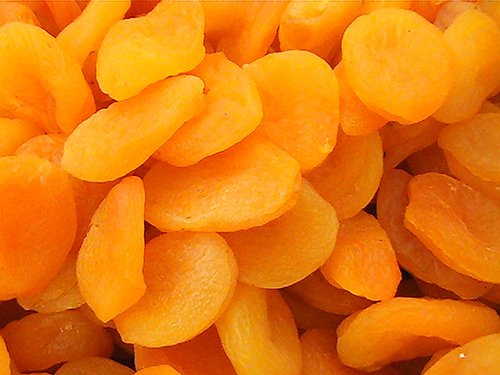
;
It doesn’t take up a lot of space
After dehydrating, food is a fraction of the size it was when it was fresh. If you want to preserve some of your garden’s bounty but don’t have a lot of storage space, dehydrating might be the best form of food preservation for you.
It’s easy to use and eat
Cooking and baking with dehydrated foods couldn’t be easier, and many dehydrated foods are simply eaten as is, as snacks. I’ve been raiding a #10 can of dehydrated apple slices the past few weeks. I just can’t get enough! If using for cooking and/or baking, most can be tossed in a pan with water and will reconstitute while cooking, like using dehydrated potatoes, carrots and onions in a soup. Others will need to soak for a few hours before using but even that takes less time than thawing.
It’s nutritious
Removing the water content reduces weight and creates a dried “superfood” which is more flavorful and nutritious, pound for pound, than fresh foods. Unfortunately any type of food preservation method will result in the loss of nutrients during processing due to heat. Dehydrated food loses some vitamin A and C while drying and vegetables especially lose nutrients because of the necessary blanching process (similar to blanching vegetables before freezing). Yet some experts maintain that drying foods is often healthier than freezing or canning because when drying, the vitamins and minerals become more concentrated. That is, you get more by eating less.
It’s versatile
From cooking with dried herbs to dried apple slices for a quick and healthy snack, there are countless ways to use dried foods. I’ll be sharing some recipes and examples for how to use dried foods later in the post.
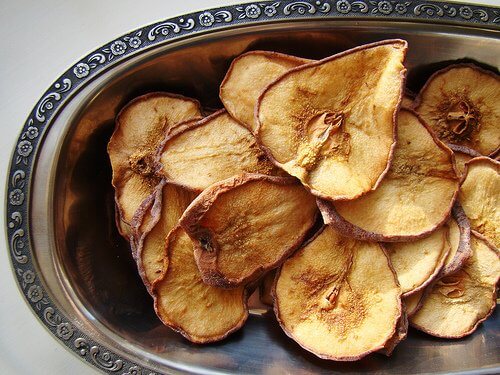
- Image by norwichnuts
What is dehydration?
When you dehydrate foods, you are drying them, removing a good portion of its moisture through evaporation. By removing moisture, you are inhibiting the growth of microorganisms and bacteria which would cause the foods to spoil. Those spoilage organisms then aren’t able to grow and multiply during storage, thus preserving the foods.
The process of dehydration isn’t rocket science, in fact, it’s really rather simple. Warm, dry air passes over, under and around the food and, in the process, pulls moisture from it.
Sun-drenched regions with low humidity, like the southwest portion of the United States, are perfect for dehydrating food with hardly any special equipment at all. In those areas, people can “sun-dry” their food, meaning drying it outdoors in the open air.
However, if the air isn’t hot or dry enough, your food may mildew or mold before it dries. For best results, often indoor drying is the best using a well-managed oven or dehydrator.
Equipment
Ovens can be used for dehydrating but must be able to go to a very low temperature, around 140*. Some ovens, like mine, don’t go that low, so in that case you’re better off using a dehydrator. A dehydrator is nothing more than a heat source with a fan to move around the warm air.
If you’re a handy and energetic cook/gardener you can make your own dehydrator.
For the rest of us, purchasing a commercial dehydrator is probably the best choice. It’s a small electrical appliance that allows you to efficiently and effectively dry food indoors.
If you are looking to purchase a food dehydrator, you will find many different options are available, and costs vary depending on features.
For a year or so, I’ve had my eye on a really nice, large dehydrator like this one. But, as of yet, my dehydration efforts don’t warrant such a large and expensive appliance. For now, I’m using a small but efficient model that cost me less than $100. I figure I’ll wear this one out with use and then upgrade. 🙂
Dehydrators can be found a variety of stores from kitchen shops to farm-supply stores and, of course, from retailers online.
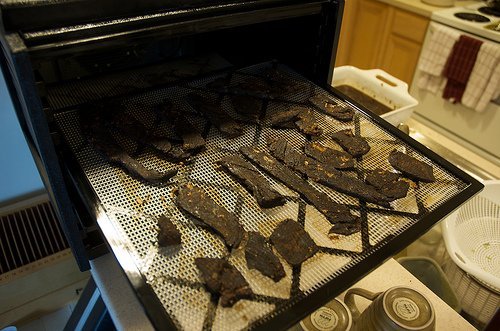
What can you dehydrate?
A better question would be what can’t you dehydrate. The options are nearly limitless when it comes to drying foods yet for best results, use foods that are fresh and in prime condition.
HERBS
Stephanie already wrote a great post on how to dry and grind herbs.
- Making Homemade Herbal Teas
- Italian Seasoning Herb Blend – Dry herbs until crackling crisp, pulverize into tiny flakes and mix together, 2 Tbl. basil, 2 Tbl. oregano, 1 Tbl. sweet majoram, 1 Tbl. thyme, 1 tea. sage. Store in an airtight glass jar in a cool, dry place.
FRUIT
Most fruit does very well dried, but especially apples, bananas, apricots and papayas.
- Fruit Leather is a fun, delicious and nutritious snack for the whole family, many love it because of it’s sweet flavor and chewy texture. Made by drying thin layers of pureed fruit in the oven or dehydrator, fruit leather’s great to take along camping and hiking – or any other outing for that matter – because it travels well and is a good source of quick energy.
VEGETABLES
There are many vegetables that also do well when dried but especially tomatoes, carrots, peppers and onions.
- Dried Vegetable Snacks – Many vegetables – like beets, carrots, parsnips, sweet potatoes, tomatoes and zucchini – make a delicious “chips” when cut thin, sprinkled with sea salt and then dehydrated.
- Homemade Baked Potato Topper – Coarsely grind dried vegetables like onions, peppers, carrots and celery. Add sea salt and use to top baked potatoes, salads or add to soups.
- Sun-dried Tomatoes
MEAT
Jerky, or salted, dried meat, has been a family favorite for centuries. Commercially produced jerky is expensive and laden with preservatives. But with the use of a low-heat oven or dehydrator, jerky can effectively be made at home.
- Homemade Beef Jerky using an oven
- Homemade Beef Jerky using a dehydrator
SEEDS and NUTS
For optimum nutrition, seeds and nuts should be soaked first to release phytic acid and other anti-nutrients which hinder digestion. Once soaked, seeds and nuts can return to their former, yet healthier, states by dehydrating. Once seeds and nuts have gone through this process, they’re then called Crispy Seeds and Crispy Nuts.
Resources:
How to Dry Foods by Deanna DeLong.
And check out the Drying sections in these great food preservation books:
Preserving Summer’s Bounty: A Quick and Easy Guide to Freezing, Canning, Preserving and Drying What You Grow. A Rodale Garden Book. Edited by Susan McClure.
Putting Food By: The Classic Work on the Best Ways to Can, Freeze, Pickle, Dry, Cure and Preserve by Janet Greene, Ruth Hertzberg and Beatrice Vaughan.



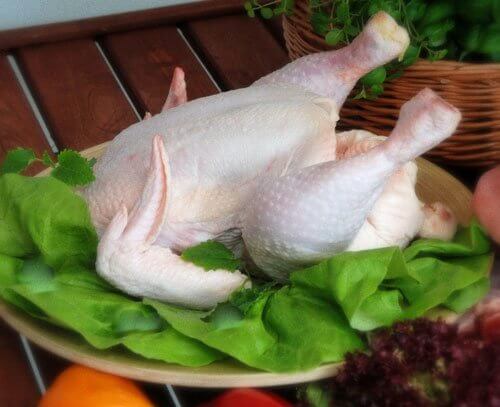
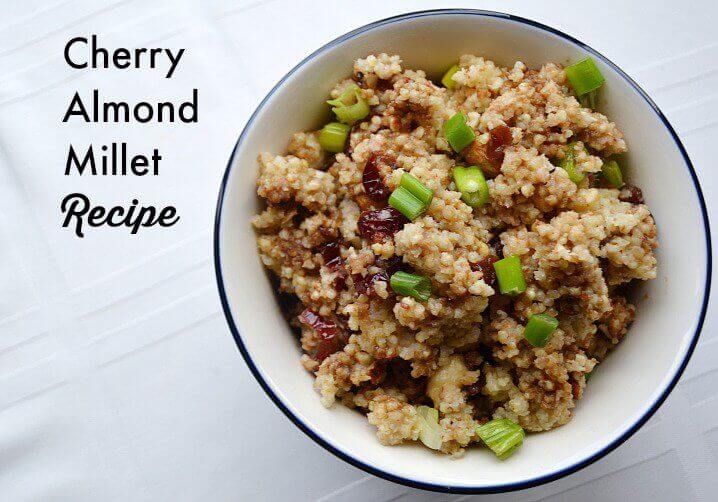
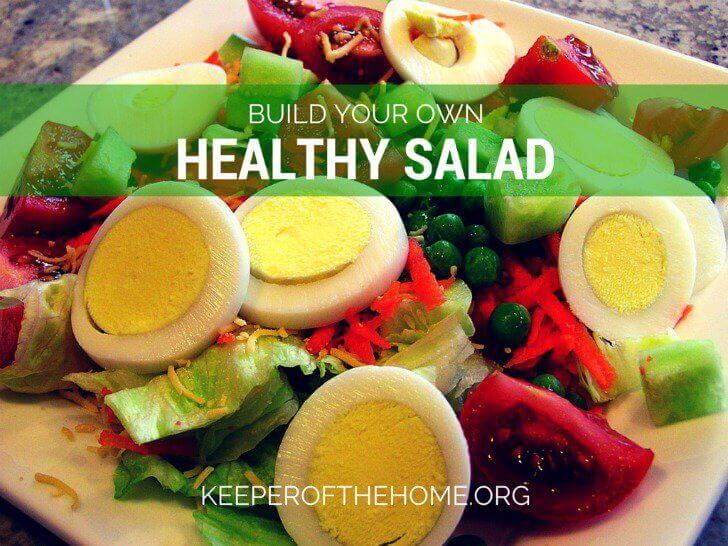
I’ve had my dehydrator for about a year and a half. I insisted on one for Christmas! I love it. I have the Excalibur 9-tray: go big or go home, lol. My husband was skeptical, but once he saw how much I used it, he asked if I wanted another one…haha. I dry sprouted grains in it, use it to incubate yogurt, dry spices (and other herbs, I have chamomile and mint this year), make jerky (a favorite of my family for sure), attempt fruit leathers, etc. Every year I find something new to do with it. I’ve considered drying lemon rinds for either teas or potpourri (yeah, you could make that!). I just love the idea of all the stuff I could make with my dehydrator! (I do can and freeze too, just depends on what I’m planning to do with it.)
@Kate @ Modern Alternative Mama, Ha Kate! Go big or go home…that is so funny. I have an Excalibur on my wishlist but have been debating on which size to get. I used to think it was very expensive, but now I consider all the things I could do with it and how much easier it would be to use than the old, cheap one I have, it seems more reasonable.
Thanks Stacey for such a thorough post. I’m ready to break out the dehydrator and make something yummy.
@Stacy @ Delighting in the Days, i’m with you stacy, it’s not that expensive when you use it for so many different things and then the fact that it lasts forever. buying for quality is definitely better than buying for price. i’ve learned that the hard way. 🙂 i haven’t put my dehydrator away since writing this and probably won’t for the rest of the summer at least.
@Kate @ Modern Alternative Mama, I’m with you, Kate. I have the big 9-tray as well. I love it and am so glad I decided to get the big one!
@Kate @ Modern Alternative Mama, i’ll have to tell my husband that, “go big or go home.” i love that! and it never occurred to me to use it to make yogurt! that’s awesome. hopefully i’ll be able to invest in a Excalibur soon – i’ve heard such wonderful things! after researching and learning so much for this post, i’m definitely going to add more dehydration to my food preservation efforts. sounds like you already do it that way 🙂
This is a great post! I’ve only dried herbs. I’m hoping to dry a lot of my garden and farmer’s market produce this year. The plan is to have bags of veggies for soup that I can just dump into the crock pot this year!
@Alicia C., that’s a great idea – healthy and a time saver too!
i found a dehydrator on a garage sale last summer for $5 (it’s little, but talk about a deal!!) i have liturally used it to death drying bananas (family fav), jerky, fruit leather, and other odds and ends. now that mine is officially dead, i’m borrowing my moms until i can save up for a new one. i don’t know why, but i never thought about doing veggies other than tomatoes. thanks for that!!
@Sarah J., that’s an awesome deal! and it sounds like you definitely got your $5 out of it. 🙂
@Sarah J., besides tomatoes, try sweet potatoes or kale! Both are yummy, my dehydrator is running right now with banana chips. Its a handy tool to have around!
I love my dehydrator too. It was actually my grandmothers – it’s had a lot of use and is still going strong. I wanted to add that garlic is another great thing to dry. Just peel the cloves and dry them whole. They last at least 6 months in the cupboard. I grind them up for garlic powder. It tastes WAY better than the commercial version and even substitutes decently for fresh garlic, depending on the recipe.
@Whopper, i want to grow garlic in a fall garden this year so i’ll have to try this! thanks!
I’ve been drying things in the car, on the dashboard and cookie sheets and in pans. In my area of the world it only takes one day to dry blueberries this way, or make strawberry sun preserves. Oh and they taste SO good!
i recently dried some fresh frozen cranberries i had in my freezer and even though i forgot to sweeten them first (tart!!), they are great in steel cut oats for breakfast! i want to experiment with making fruit leathers as well and sun-dried tomatoes once my garden is really producing.
How did you do the cranberries? Did you just put them from the freezer into the dehydrator? I’ve been wanting to dehydrate some cranberries I have frozen and everything I find online is for cooked/sweetened dehydrated cranberries.
You know, I think those who keep veggie gardens, garden for different reasons… for me, I think it is so gratifying and motivating when I have an abundance of produce to preserve or share with others. a little 4×4 square foot garden SO wouldn’t cut it for me 🙂 (though it’s better than nothing!!). I’m in my 4th year of gardening my 12×25 terraced garden and this will be my first year my strawberries will produce more than we will eat in a day or two! Right now, I’m freezing everything but I want to get a dehydrator. The Excalabur was mentioned on another blog I read as a great device for incubating yogurt – which I’ve been making homemade yogurt in my crockpot for a couple of years now – and though it is zero cost (assuming you have a crockpot) I think I’m ready for something that has fewer variables. (the crock method varries depending on seasons, insulation around the crock and I pretty-much have to babysit it while it incubates)
I’m so glad I found your blog though Plan to Eat and Nourishing Days – I am now a subscriber! Thanks!
@Jenny, So glad your’e here, Jenny! And how exciting about your strawberries… I can’t wait to have enough space to grow some. My garden is just never big enough for all that I want to grow. 🙂
I would definitely look into the Excalibur. It’s what I use and love. I had an old, round American Harvest for years, but I would never go back now.
I am so glad to see this post! I received a dehydrator for Christmas, but have mostly just felt overwhelmed by it so far. Honestly, all I have used it for is soaked and then dehydrated almonds and a soaked granola.
I am really looking forward to making use of my dehydrator this summer. Thank you so much for the great ideas! It gives me a boost of confidence and the encouragement to try dehydrating some things. Fun!